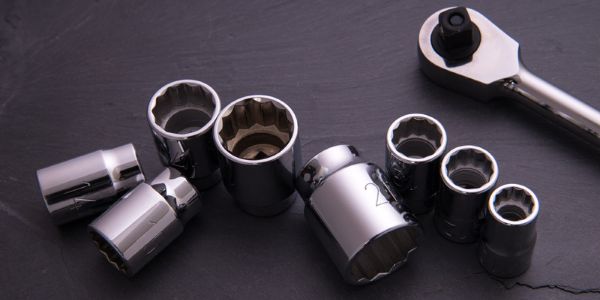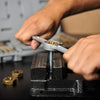
Understanding Different Types of DIY Ratchets and Sockets
A ratchet and socket set is an essential tool for any DIY enthusiast, handyman, or homeowner. These versatile tools are used in various applications, from automotive repair to home improvement projects.
This in-depth article will provide a comprehensive understanding of different types of DIY ratchets and sockets, discussing their components, materials, and use cases.
By the end of this article, you will be better equipped to select the appropriate ratchet and socket for your specific needs and ensure their proper maintenance and care.
-
Understanding Ratchets
- Types of Ratchets
- Ratchet Mechanism
- Ratchet Handles
- Ratchet Sizes
- Understanding Sockets
- Types of Sockets
- Socket Sizes
- Drive Size Compatibility
- Socket Materials
- Using Ratchets and Sockets
- Proper Socket Selection
- Maintenance and Care
- Conclusion
Understanding Ratchets
A ratchet is a mechanical device that allows continuous linear or rotary motion in one direction while preventing motion in the opposite direction. In the context of DIY tools, ratchets are primarily used to tighten or loosen fasteners such as nuts and bolts.
Types of Ratchets
There are several types of ratchets available on the market, each with its unique features and benefits:
- Standard Ratchet: The most common type of ratchet, featuring a gear mechanism that allows the user to turn the fastener without removing the socket from it.
- Flex Head Ratchet: A variation of the standard ratchet, featuring a flexible head that can pivot, providing better access to tight or awkward spaces.
- Stubby Ratchet: A shorter version of the standard ratchet, designed for use in confined spaces where a full-sized ratchet would be too cumbersome.
- Long Handle Ratchet: A ratchet with an extended handle, offering increased leverage and torque for more difficult fastening tasks.
- Torque Wrench: A specialized ratchet that measures the amount of torque applied to a fastener, ensuring proper tightening without over-tightening.
Ratchet Mechanism
The ratchet mechanism consists of a gear wheel and a pawl (a lever with a hook). The gear wheel has teeth that engage with the pawl, allowing the ratchet to move in one direction while preventing movement in the opposite direction.
There are two primary types of ratchet mechanisms:
- Fine-Tooth Ratchet: These ratchets have a higher number of teeth on the gear wheel, allowing for smaller movements between clicks. Fine-tooth ratchets provide greater precision and control but may not be as durable as coarse-tooth ratchets.
- Coarse-Tooth Ratchet: These ratchets have fewer teeth on the gear wheel, resulting in larger movements between clicks. While they may not offer the same level of precision as fine-tooth ratchets, coarse-tooth ratchets tend to be more durable and require less maintenance.
Ratchet Handles
Ratchet handles come in various styles and materials to suit different user preferences and applications:
- Straight Handle: The most common type of ratchet handle, featuring a straight design that provides a comfortable grip and good leverage.
- Offset Handle: A ratchet handle with a slight angle or bend, allowing for better access in tight spaces and improved ergonomics.
- T-Handle: A ratchet handle shaped like the letter "T," providing additional leverage and control for specific applications, such as working on bicycles or motorcycles.
Handles can be made from different materials, including steel, aluminum, and plastic. The choice of material will affect the ratchet's weight, durability, and overall feel in the user's hand.
Ratchet Sizes
Ratchets are available in various sizes to accommodate different socket sizes and drive types. The three most common ratchet sizes are:
- 1/4-inch Drive: Ideal for light-duty tasks and small fasteners, commonly used in electronics, appliances, and automotive interiors.
- 3/8-inch Drive: A versatile size suitable for general-purpose use, capable of handling most medium-sized fasteners and offering a good balance between strength and accessibility.
- 1/2-inch Drive: Designed for heavy-duty applications, providing increased torque and leverage for larger fasteners, often used in automotive repair and construction projects.
Understanding Sockets
Sockets are the cylindrical attachments that connect to the ratchet handle and engage with the fastener. They come in various sizes and styles to fit a wide range of fasteners and applications.
Types of Sockets
There are several types of sockets, each designed for specific purposes:
- Standard (Shallow) Socket: The most common type of socket, designed for general use and suitable for most applications.
- Deep Socket: A longer socket that provides additional reach for fasteners in recessed locations or when extra clearance is needed.
- Impact Socket: A more robust socket designed for use with impact wrenches and air tools, featuring thicker walls and a black oxide finish for increased durability and resistance to wear.
- Universal (Swivel) Socket: A socket with a built-in swivel joint, allowing for greater flexibility and access to fasteners in tight or awkward spaces.
- Bit Socket: A socket with a built-in bit (such as a hex or Torx bit) for use with specialized fasteners.
Socket Sizes
Sockets are available in various sizes to accommodate different fastener sizes and drive types. They are typically measured in either metric (millimeters) or imperial (inches) units, depending on the region and application.
Drive Size Compatibility
It is essential to ensure that the socket's drive size matches the ratchet handle's drive size. Using an incompatible socket and ratchet combination can result in poor performance, increased wear, and potential damage to both tools.
Socket Materials
Sockets are typically made from steel, with various finishes and coatings applied to increase durability, corrosion resistance, and overall performance. Common socket materials and finishes include:
- Chrome Vanadium Steel: A popular material for sockets, offering a good balance between strength, durability, and corrosion resistance.
- Chrome Molybdenum Steel: A stronger and more durable steel alloy used primarily in impact sockets.
- Black Oxide Finish: A protective coating applied to sockets, providing increased durability and corrosion resistance.
Using Ratchets and Sockets
Proper Socket Selection
When using ratchets and sockets, it is crucial to select the appropriate socket for the specific fastener and task at hand. Using the wrong socket can result in poor performance, increased wear, and potential damage to both the tool and the fastener.
Here are some guidelines for proper socket selection:
- Ensure the socket's drive size matches the ratchet handle's drive size.
- Choose the correct socket type (standard, deep, impact, universal, or bit) based on the application and fastener location.
- Select the appropriate socket size (metric or imperial) based on the fastener size and regional standards.
Maintenance and Care
Proper maintenance and care of ratchets and sockets will ensure their longevity and optimal performance. Here are some general maintenance tips:
- Keep ratchets and sockets clean and free of dirt, debris, and grease.
- Apply a light coating of oil to the ratchet mechanism and socket's interior to prevent rust and maintain smooth operation.
- Store ratchets and sockets in a protective case or organizer to prevent damage and keep them organized.
- Inspect ratchets and sockets regularly for signs of wear or damage and replace them as necessary.
Conclusion
Understanding the different types of DIY ratchets and sockets is crucial for any handyman, hobbyist, or homeowner.
By familiarizing yourself with the various components, materials, and use cases of these versatile tools, you can make informed decisions when selecting the appropriate ratchet and socket for your specific needs.
Additionally, proper maintenance and care will ensure the longevity and optimal performance of your ratchet and socket set, making them invaluable assets in your DIY toolkit.



